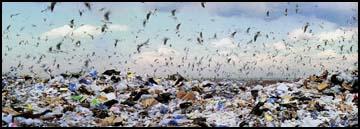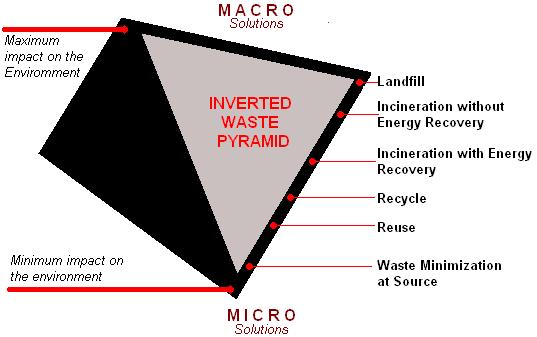
Info Sheets |
-
The Inverted Pyramid
for Solid Waste ManagementHari Srinivas
Traditionally, urban solid wastes are managed in a hierarchy that looks like an inverted pyramid shown below. At the broad top is landfill, which is a macro solution applied at the level of the city. Very little of the waste is processed or treated in any way, and indeed have a maximum impact on the environment.
At the narrow bottom of the inverted pyramid is waste minimization at source. This is a micro solution to waste management, applied at the level of an individual and household, or a business/industry - at the place where the waste is actually generated. Here a conscious effort is made to reduce the amount of waste generated - indeed to avoid situations where waste is generated. The impacts and effects on the environment at this level minimal.

A second aspect to note is the technical inputs needed increases at the upper levels of the pyramid, than at the lower level. Also, the degree of partnerships needed varies along the pyramid. At the upper levels, it is almost the exclusive perview of local governments, with little inputs from other stakeholders. The bottom of the pyramid derives maximum inputs from a range of stakeholders - where everyone has a role to play.
The Inverted Waste Pyramid provides a big picture in the solid waste management process, and helps in understanding the different inputs and and advantages/disadvantages of each level.
| Level of the Pyramid | Description | Japanese Examples |
|---|---|---|
| Landfill (Top - Macro) | Waste is disposed with minimal processing, highest environmental impact. |
Yumenoshima (Tokyo): Former landfill site now repurposed into a public park. Strict landfill regulation due to land scarcity. |
| Incineration without Energy Recovery | Burning waste without capturing energy, older and less sustainable method. | Older facilities still exist but are being phased out under the Waste Management Law. |
| Incineration with Energy Recovery | Waste-to-energy plants that generate electricity and heat. |
Shin-Koto Incineration Plant (Tokyo): Produces electricity and supplies heat. Community-friendly "Clean Centers" across many cities. |
| Recycling | Processing materials for reuse in new products. |
Containers and Packaging Recycling Law: Producer responsibility scheme. Kamikatsu (Tokushima): 45-category waste sorting for high recycling rates. |
| Reuse | Extending product life by using items again as-is. |
Thriving second-hand markets like Book-Off and Hard-Off. Municipal reuse shops at waste stations. |
| Waste Minimization at Source (Bottom - Micro) | Preventing waste generation through conscious decisions. |
Kamikatsu Zero Waste initiative: Home composting, citizen education. Mottainai culture: Influences personal and corporate behavior. Food waste reduction in supermarkets and convenience stores. |
| Return to Urban Waste Contact: Hari Srinivas - hsrinivas@gdrc.org |